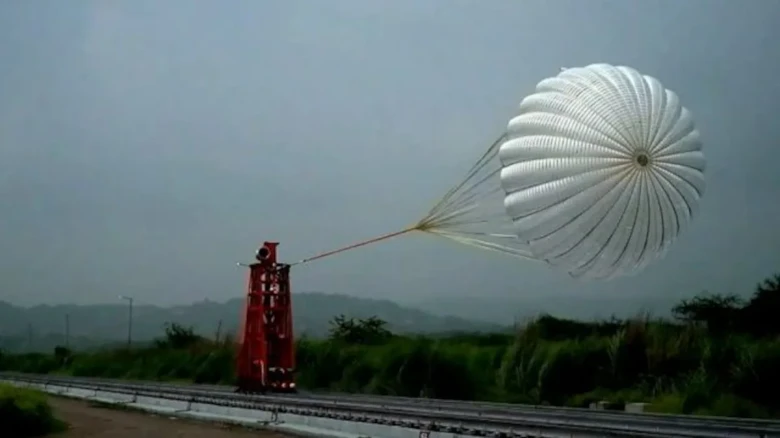Regional

These parachutes are a crucial component in stabilizing the crew module and reducing its velocity during re-entry for the upcoming...
Digital Desk: The Indian Space Research Organisation (ISRO) has achieved a significant milestone in its Gaganyaan mission by successfully conducting a series of tests on drogue parachutes. These parachutes are a crucial component in stabilizing the crew module and reducing its velocity during re-entry for the upcoming human space flight mission.
The Gaganyaan mission, India's ambitious endeavor to transport astronauts to space and bring them back safely, is a significant step forward in the country's space exploration program. The series of tests focused on drogue parachutes, which play a pivotal role in ensuring a controlled and safe descent of the crew module.
Drogue parachutes, well-known for their ability to reduce speed and stabilize rapidly moving objects, were tested meticulously at the Rail Track Rocket Sled (RTRS) facility of the Terminal Ballistics Research Laboratory in Chandigarh. The tests took place from August 8 to 10 and were conducted in collaboration with the Aerial Delivery Research and Development Establishment (ADRDE) under the Defense Research and Development Organisation (DRDO).
The tests involved the deployment of conical ribbon-type parachutes with a diameter of 5.8 meters. These parachutes, cleverly packed within pyro-based devices known as mortars, are designed to eject upon command. They employ a single-stage reefing mechanism that minimizes canopy area and reduces opening shock, ensuring a controlled and smooth descent.
During the rigorous tests at the RTRS facility, a range of real-world scenarios were simulated to evaluate the performance and reliability of the drogue parachutes. The first test simulated the maximum reefed load, marking a significant milestone as reefing was introduced in a mortar-deployed parachute for the first time in India. The second test focused on the maximum disreefed load, while the third test demonstrated the deployment of the drogue parachute under conditions resembling the maximum angle of attack experienced during the crew module's mission.
"These successful RTRS tests serve as a critical qualification milestone for the drogue parachutes, confirming their readiness for integration into the upcoming Test Vehicle-D1 mission," stated ISRO. Earlier this year, the successful tests of the Pilot and Apex cover separation parachutes further highlighted the progress of the Gaganyaan mission's parachute system development.
The entire parachute sequence for the Gaganyaan crew module's deceleration system involves a total of 10 parachutes. The sequence begins with the deployment of two apex cover separation parachutes, followed by the stabilization achieved through the deployment of two drogue parachutes. Upon the release of the drogue parachutes, the mission transitions into the extraction phase, where three pilot chutes individually extract three main parachutes, crucial steps in reducing the Crew Module's speed to safe levels for a secure landing.
The success of these tests underscores ISRO's dedication to ensuring the safety and effectiveness of the Gaganyaan mission. With each milestone achieved, India's journey towards becoming a significant player in space exploration gains momentum, bringing the nation closer to its aspirations of human spaceflight.
Leave A Comment